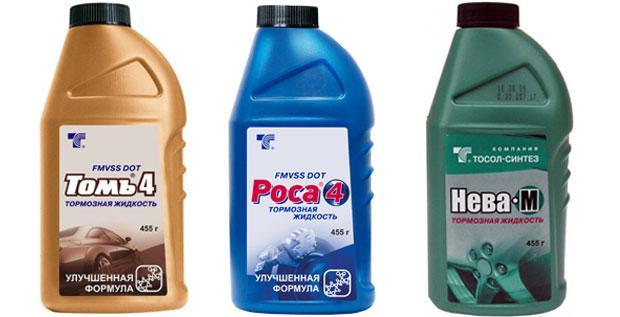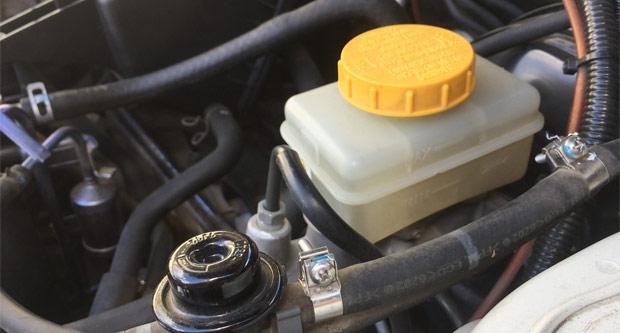
Brake fluid "Tom". Let's support local manufacturers!
Features of the properties of low-temperature brake fluids
Driving in winter is characterized, on the one hand, by a lower heating intensity of the brake systems, and, on the other hand, by the ability of the brake fluid not to crystallize at the lowest possible temperatures. Such fluids must also have a minimum allowable density, which will reduce the load on the corresponding control pedal.
Brake fluid "Tom" is produced in two classes - the third (suitable for DOT3 conditions, which are determined by the international standard FMVSS No. 116) and the fourth, which corresponds to the DOT4 point. Physical and mechanical parameters for these media also differ:
| Name | Kinematic viscosity range, cSt for temperatures from 400C to + 1000C respectively | The boiling point of a "dry" liquid, 0С | The boiling point of a "wet" liquid, 0С | pH value |
| Tom B (for DOT3) | 1500 ... 2,0 | 205 | 140 | 7,0 ... 11,5 |
| Tom A (for DOT4) | 1800 ... 2,0 | 230 | 160 |


Of the main characteristics of the described brake fluid, it is worth mentioning its color - from light yellow to dark yellow, as well as the ability to light opalescence in sunlight. The packaged product does not contain sediments and mechanical suspensions.
Objective indicators determined in accordance with the norms TU 2451-076-05757-618-2000 (there is no GOST for this product) allow us to state that Tom:
- Will not harm any rubber components in the vehicle's braking system.
- Provides adequate corrosion resistance of metal parts of the car in contact.
- Can be mixed with any non-silicone based products of similar application.
Other brands of similar products also differ in similar consumer qualities (in particular, Neva and Rosa brake fluids).


Using
Among car owners, there is often a practice of using different brands of brake fluids, even within the same season. In order to ensure such intercompatibility, the manufacturer once developed "Tom" based on alcohol-containing polyglycol components with corrosion inhibitors as additives. Having two grades corresponding to the DOT3 and DOT4 points also increases the range of use of the product.
According to the studies performed, the class III or IV class of brake fluid "Tom" mainly affects the ability of the product to absorb moisture. So, "Tom B" can absorb up to 2 percent of moisture from the air from the environment, thereby increasing its initial volume. At the same time, corrosion risks increase for metal parts of the vehicle’s brake system, and liquid vapors formed during active braking are localized in a relatively small volume. Therefore, with its systematic use, "Tom" grade B can contribute to damage to rubber parts.


At the same time, "Tom" grade A is characterized by a lower ability to absorb water, since its boiling point is higher than for grade B. Experts advise to selectively mix both types of "Tom" brake fluid. In particular, it is undesirable to add grade A to the brake and clutch systems, where Tom B of grade B was previously used, while the reverse replacement is acceptable.
The brake fluid in question is flammable, and inhalation of its vapors is harmful to health. The shelf life of "Tom" (even in hermetically sealed containers) should not exceed three years.
The approximate price is:
- When packing in plastic containers 0,455 l - from 100 rubles. (for "Tom" A) and from 60 rubles. (for "Tom" B).
- When packing in a container of 910 ml - from 160 rubles.
- When packing in canisters with a capacity of 5 liters - from 550 rubles.


Watch this video on YouTube

